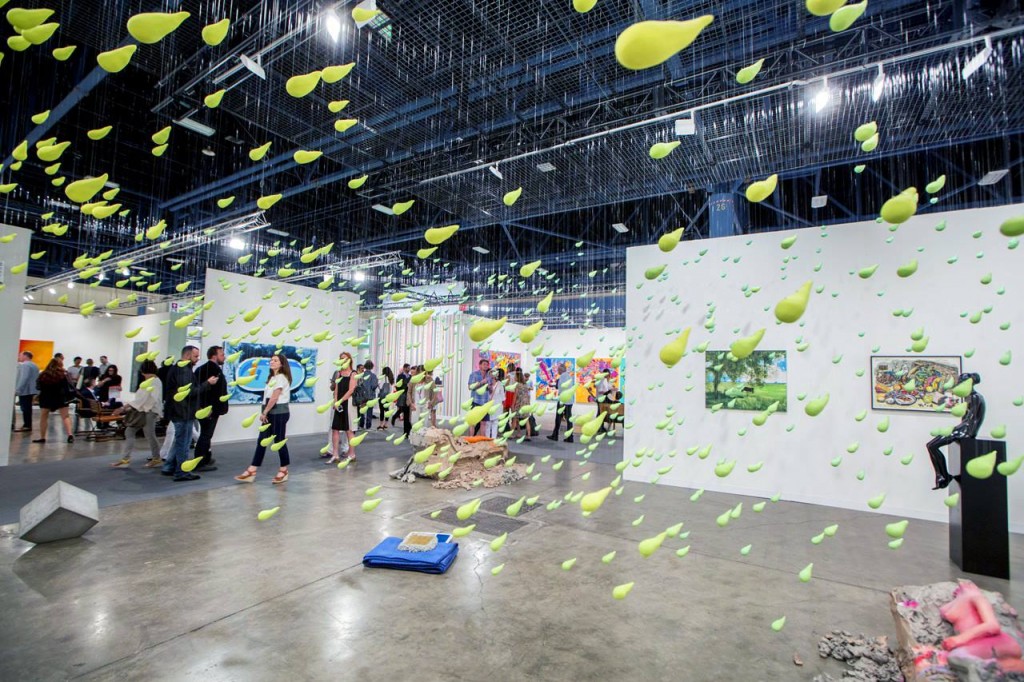1.02am ET
And with that it’s probably time to conclude this live blog. Art Basel Miami Beach has been an exhilarating, at times queasy, but always fascinating cocktail of art, ideas, partying and, of course, money. Out of all the above, of course, it’s the art that’s designed to endure and which has left the biggest impression on me, despite the surrounding circus.
That said, Horse Meat Disco on Wednesday night was one heck of a party. Thanks very much for reading this. And finally …
If you do not post a picture fake caring about a painting did you really go to art Basel?
— ; (@DAREALLEXLUGER) December 6, 2014
And furthermore …
Fin pic.twitter.com/RyLHFb70kV
— Alex Needham (@alexneedham74) December 6, 2014
12.53am ET
The New York Post is reporting that someone stole a Picasso worth almost $90,000 from Art Miami, one of the satellite art fairs. It’s a silver plate called Visage aux Mains, and one of an edition of 20.
David Smith, owner of the Leslie Smith Gallery told the Miami Herald he had arrived his the booth Friday to find an empty spot on the wall where the artwork had been.
“I’ve been doing art shows all my life … I’ve never, ever had anything stolen.”He reported the theft to Miami police, who were photographed dusting for fingerprints Friday morning. A police spokesperson said there was no video surveillance or witnesses to the theft.
12.48am ET
There was only one way to conclude my Miami art experience, and that was to go and look at the collaboration between Andre 3000 of Outkast, filmmaker Greg Brunkella and painter Jimmy O’Neal. Andre 3000’s contribution consisted of 48 jumpsuits displayed on mannequins, each with a slogan such as “thinking deeply about shallow sh#t”, “make love like war” and “big girls are beautiful to me”, each of which he’s worn on Outkast’s tour of the summer festivals this year.
Andre explained to the Fader that he was more enthusiastic about the jumpsuits than the tour, which he said he did for the money – hence the price tag “sold” he wore each night, also on display. As for the slogans:
“I live my life out on stage and everywhere else, I don’t necessarily have to tweet it out,” Andre said. “But I felt like it was cool that I could say crazy thoughts or fun stuff. And I think it actually gets more attention because it is what it is instead of tweeting it. And Twitter, from what I know of, you only have a certain amount of characters, like 150. My space was just right here,” he said, pointing to his chest. “Everything had to go here. So I had to squash and edit words.”
I didn’t feel that the other two elements of the show, the abstract, splodgy abstract paintings and a moody black and white film juxtaposing the slogans with images of beautiful young people, really added much, and if it was a “socially dynamic conversation about language and context” it seemed a bit basic to me. Yet in the mix of Art Basel, there’s something refreshing about people like Andre 3000 and even Miley Cyrus trying to think beyond music, especially since we’re often told that the art school tradition in pop is dead and buried.
I finally made it, @Lanre_Bakare pic.twitter.com/4z4uXCEmPv
— Alex Needham (@alexneedham74) December 5, 2014
Updated at 1.03am ET
12.34am ET
Apologies for the enormous pause. This afternoon I visited the National YoungArts foundation in downtown Miami. As well as staging gigs this week by the likes of FKA Twigs, they’ve got an excellent exhibition on curated by Moma’s Klaus Biesenback called Zero Tolerance Miami. It’s a version of a show currently being exhibited in New York, and a moving and impressive one, all the more so in Art Basel Miami Beach’s hyper-commercial context.
All the works deal with protest, from Pussy Riot’s church performance that got them two years in jail to a work called East Side Story by the Croation artist Igor Grubić. This is a two-channel video piece; on one is footage of a gay rights march in Zagreb being heckled by a viciously hostile crowd, and then turning violent. On the other, dancers mimic the movements in the footage. It’s a powerful and, for me, upsetting watch.
Also extraordinary is Amal Kenawy’s Silence of Sheep, a performance piece from 2009 in which she got a group of people to crawl through the centre of Cairo – a meditation on poverty, control and lack of agency which got an angry response from a group of passersby. It’s unnerving viewing, even more so given Egypt’s revolt and counterrevolution since.
Amal Kewany’s Silence of Sheep pic.twitter.com/ABV4pfUYWG
— Alex Needham (@alexneedham74) December 6, 2014
I was also struck by Voina’s Operation: Kiss Garbage in which women from the prankish, subversive arts collective which birthed Pussy Riot forcibly snog policewomen in protest at the police reform laws. Perhaps it’s purile, but there’s no denying the action’s bravery.
Voina’s Operation: Kiss Garbage pic.twitter.com/Y95fWRRTZD
— Alex Needham (@alexneedham74) December 6, 2014
Overall, it was great to get away from the frenetic marketplace of Art Basel and spend time with work that had something to say.
11.41am ET
I’m now leaving the Guardian’s makeshift office (my hotel room) but will be back to round off this live blog later on. Hopefully in the meantime I’ll see some art too – or at least Andre 3000’s jumpsuits. Please tweet me with any Art Basel observations @alexneedham74.
Fernando Botero, ‘Picnic/Still Life with Lamp’, 1968/63 at Landau Fine Art, Inc. #ABMBgalleries #ArtBasel pic.twitter.com/PyJtC1yMP9
— Art Basel (@ArtBasel) December 4, 2014
11.13am ET
More from the shop floor: a 2007 Damien Hirst called Love Remembered went for $4m yesterday. It’s from his medicine cabinet series and looks like this. There was an error in the John Chamberlain price sent out yesterday, however. Rather than $5m, it sold for a mere $3m.
Artnet have an interesting report on the sales which you can read here. Here’s an excerpt:
New York dealer Sean Kelly told artnet News: “I would say so far it’s an absolutely extraordinary start to the fair.” His eponymous gallery has exhibited in Miami since the start 13 years ago and he characterized the recent opening days as the “strongest” to date.
Kelly said that what was particularly interesting was the depth of collecting from Latin American countries. “The fair has always drawn those with second homes in Miami, particularly from Brazil, but this time we are getting collectors from Uruguay, Paraguay, Argentina, all across Mexico, and Chile. It’s much deeper and stronger than we have ever seen.”
Updated at 11.16am ET
10.52am ET
I also attended an interesting talk at Art Basel Miami Beach titled Instagram as an Artistic Medium. The moderator, art producer Bettina Korek, kicked off by saying that Instagram is variously used by artists as a sketchpad, archive and branding tool, before introducing a panel consisting of Argentine artist Amalia Ullman, Instagram CEO Kevin Systrom, auctioneer Simon de Pury and curators Hans Ulrich Obrist, from the Serpentine in London, and Klaus Biesenbach, from Moma/PS1. The latter clearly had fun at Ryan McNamara last night:
Ullman kicked off with a presentation about an art project she’d created on Instagram where she basically pretended to be a troubled woman who went through a kind of Rake’s progress from sexually aggressive girl on the hunt for rich men through addiction and plastic surgery to post-rehab tranquility. She said, or seemed to imply, that there are a significant section of Instagram’s users (and on the web at large) who are envious, and like seeing other people fail and mess up, and that the platform enables this.
It contrasted violently with the following section, by Systrom, who said that the most important thing about Instagram was its authenticity and community, but unfortunately this implicit argument wasn’t really explored. Systrom said that Instagram aims to inspire creativity, and that its potency lies in its simplicity: “If you create simple systems you can foster emergent behaviour. Simplicity is the key to power.”
The session really caught fire when Simon de Pury started to speak. He believes that Instagram has turned everyone into an artist and an editor. His favourite people to follow include Snoop Dogg: “he posts more than everyone else I know and it’s always entertaining.” He added that Instagram now means that we see the world in square images rather than rectangular ones.
The most striking part of the whole session was when de Pury recounted the story of artist Tanya Ling, who was offered her first art exhibition purely on the strength of her Instagram feed (which is beautifully curated – take a look). She exhibited paintings and sculptures rather than photographs, and Damien Hirst stopped by and bought the lot.
De Pury finished with some requests for more functionality. He wants to be able to rearrange his griid and to see what his most and least popular images have been. Systrom promised to look into it.
Obrist uses his Instagram feed to post post-it notes on which artists have written or doodled, which he said was inspired by Umberto Eco’s call to bring handwriting back. Biesenbach, meanwhile, uses the app in a much more diaristic style – he said it was like sending a postcard. Given the circles he moves in, they star people like Lana del Rey and James Franco. But Biesenbach ended his talk by reminding the audience that social media is also a tool for activism, citing a post-Sandy benefit he organised via Twitter and Instagram. He concluded that the app “changed my life”. Certainly it’s changed the art world, but the participants (apart from Ullman) seemed a bit too starry-eyed about it to dig into the implications.
9.43am ET
Yesterday, in the late-afternoon, we also posted my interview with the British conceptual artist Ryan Gander, who is showing a couple of specially-commissioned artworks. One of them is two bodyguards who follow the curator Nicholas Baume around all day. Gander said that the work was conceived with Miami in mind:
“It fits because of the ridiculous context of it being all flashing and beeping and million different colours, celeb central and everyone’s ‘Have you seen Jay Z?’ The bodyguard’s in that whole language of visibility – seeing and being seen. When you see the bodyguards walking around there’s an immediate change in the atmosphere around him because people think there’s a celebrity there. It’s a weird spatial dynamic.”
He also had stern words for the superfician, emoticon-dotted work he calls “crapstraction”. Read the interview here.
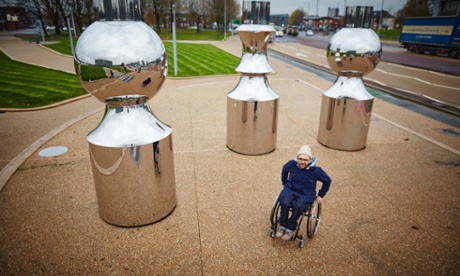
9.28am ET
It’s our final day at Art Basel Miami Beach
… and by “our” I (Alex) mean mine as Jason is safely back in New York. Last night I went to a preposterous event with that noted art world figure, Kim Kardashian.
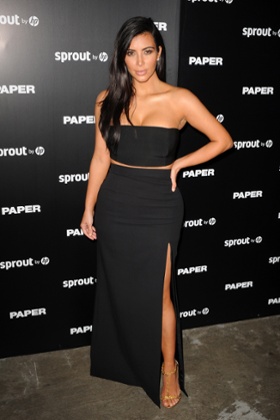
It took place in – no lie – a windswept parking lot high above Miami Beach’s Lincoln Street with admittedly great views, and was organised by Paper magazine, whose booty-centric Kim cover shoot launched umpteen thinkpieces last month.
Dinner with Kim pic.twitter.com/MEGHO3FDCV
— Alex Needham (@alexneedham74) December 5, 2014
The belle of the ball turned up at about 9pm, surrounded at all times by a crush of people wielding camera phones, which must get somewhat wearing. Like the vast majority of celebrities, she’s pretty titchy in the flesh. Fortunately for her, she has the largest bodyguard I’ve ever seen. I accidentally got in his path before she arrived, and he gently but firmly moved me away like a chess piece. I’m 6’3 – it was a very strange experience to be manhandled by someone bigger than me.
The assembled hacks, liggers and hipsters who seemed to make up the rest of the guest list then sat down to dine. Kim took a circuitous route to her seat, apparently because the whole thing was being filmed for Keeping Up With the Kardashians. I was sat next to a gossip columnist at dinner who kept anxiously getting up from his paella to see if he could get photographed with Kim in time-honoured Piers Morgan style. The Paper magazine staff all seemed to get their pictures taken with her – something that would never happen in the UK as British mags would assume that the readers wouldn’t care:
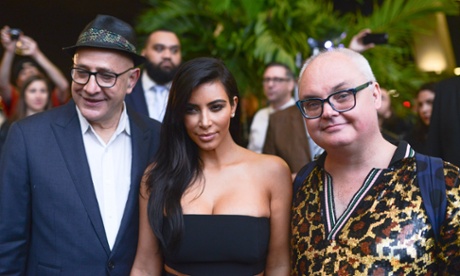
Kim wasn’t doing any interviews so these devastating insights are about all I have to offer, though you can fill your boots with Mail Online’s comprehensive take on the event here.
She did tweet though, of course:
Thank you Paper Magazine for the best dinner party at Art Basel! pic.twitter.com/yWwnZUF6S8
— Kim Kardashian West (@KimKardashian) December 5, 2014
Updated at 9.54am ET
4.05pm ET
I (Alex) am heading back to the fair now for a talk about Instagram as an artistic medium with a heavyweight panel including Simon de Pury, Hans Ulrich Obrist and Moma curator Klaus Bisenbach.
4.03pm ET
Bloomberg have written an interesting report about who’s buying what – apparently Leonardo DiCaprio bought a 1973 Frank Stella painting for an undisclosed sum, while a Sigmar Polke went for $1m. It finishes with this killer quote from gallerist Larry Gagosian:
Gallery owner Larry Gagosian declined to say which pieces sold. “We don’t brag, we don’t talk,” he said. “We just want the quiet thud of a check on our desk.”
3.39pm ET
Rodman Primack, director of Design Miami, had a so-fresh-and-so-clean visitor today:
3.37pm ET
Jason writes: Now that the fair is open and the big deals have been done, Miami is getting down to the real business of Basel week: conspicuous consumption. I find myself at a luncheon for the Metropolitan Museum of Art, held on the premises of something called the Faena Forum. The Faena Forum, designed by Dutch architect Rem Koolhaas, is the latest privately funded arts institution to open in Miami Beach — or will be. At the moment it is a working construction site, which is not enough to stop the organization from throwing a massive party. Someone just pulled up in a Rolls Royce:
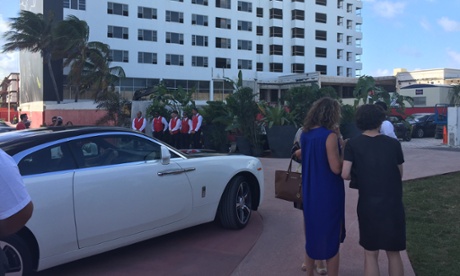
I saw a few people I recognized: Met curators Sheena Wagstaff and Nick Cullinan, Studio Museum director Thelma Golden, dealers David Zwirner and Dominique Lévy, and the artist Katrín Sigurdardótir. But mostly the crowd seems to be property developers and the women (and men) who love them. No one seemed particularly concerned to be quaffing cocktails and gobbling food on a work site.
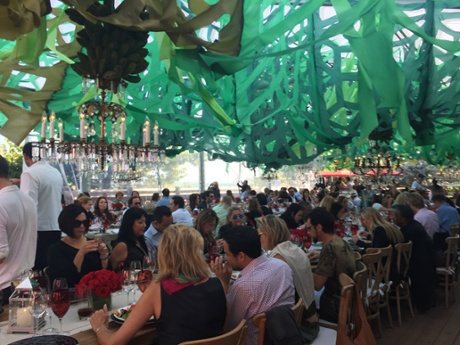
3.13pm ET
Imagine the bashing of a gavel as I tell you that I’ve just received a press release telling me that John Chamberlain’s 1964 sculpture Miss Remember Ford has just been sold for a hefty $5m.
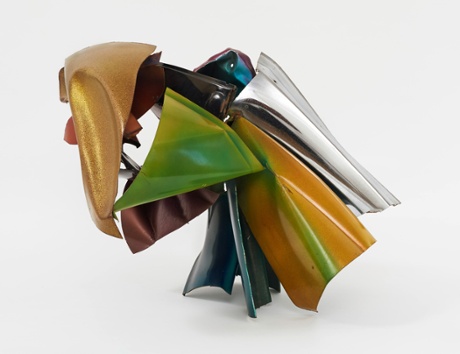
2.49pm ET
The Art Basel search term on Twitter has been almost entirely overrun with Miley, though I did spot this refusenik:
1.26pm ET
Interesting choice of illustration for this tweet:
When we see a work of art, we ask each other a simple question: does it speak to you? http://t.co/NkLQtUwzW3 pic.twitter.com/NQmgP82Wq0
— BlackBook Magazine (@BlackBook) December 4, 2014
1.19pm ET
Nada, with its free entry and lower price points (nothing much over $20,000 — a steal, by this town’s oligarchical standards), is a much more relaxed affair than Basel once the initial morning dash has passed. Collectors are in T-shirts or sundresses, and drink complex green juices rather than champagne. There’s no VIP section, and the mood is light.
Also unlike at Basel, Nada has pretty rudimentary booth design — just a few white walls, really — so dealers wanting to show additional works can be seen shuttling through the hotel, fetching art from far-off storage closets (like this rather awful painting of a bacon cheeseburger; no accounting for taste, I suppose).
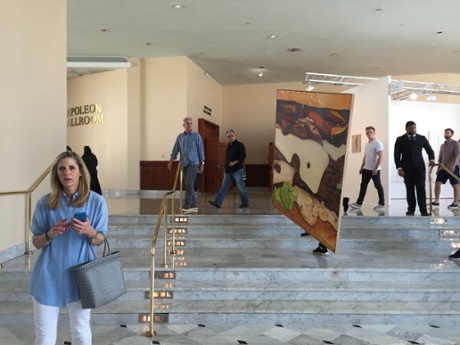
There is also, unlike at the convention center, natural light. Though the view of the beach is so picture perfect you wonder if you should just give up on art and hit the surf.
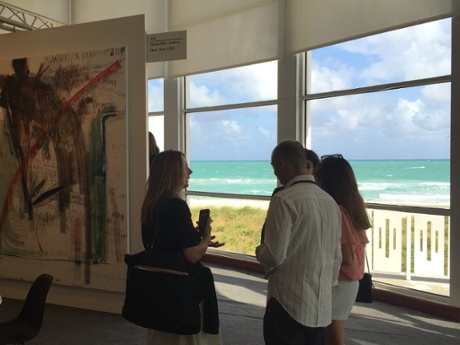
1.10pm ET
It’s not all polite abstraction and small-scale drawing at NADA. On the booth of Eleven Rivington, a punks-with-money New York gallery, there’s a large upturned psychedelic hot tub, or maybe an oversized takeout container — the work of the artist Mika Tajima. Sold, alas.
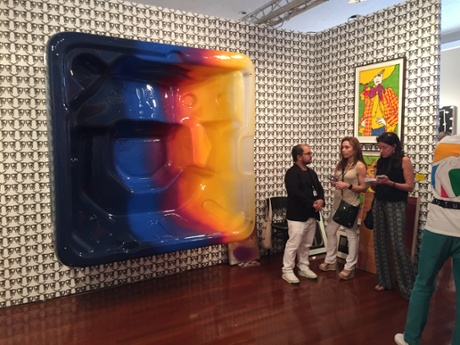
1.06pm ET
One of the open questions ahead of NADA’s opening today was whether the young-galleries fair could still muster top quality work now that Art Basel has grown so big. A lot of the best young galleries from New York, Los Angeles and London are in the main fair rather than here. But NADA does still surprise. One welcome inclusion is Galeria Sabot, from Cluj, Romania – a small city which, if you believe the hype, is an upcoming art hotspot.
The gallery is showing work by the painter Razvan Botis, who seems to enjoy painting the wrong sides of canvases, then arranging them in sculptural fashion. Perhaps something got lost in translation.
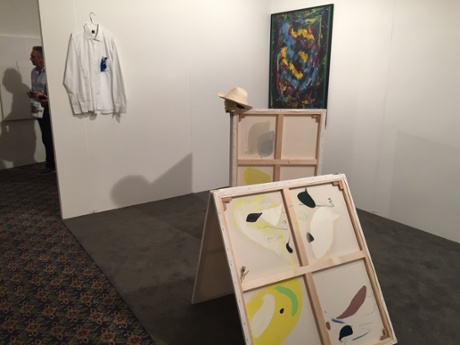
1.00pm ET
At the booth of Callicoon Fine Arts, one of the more thoughtful small galleries on New York’s Lower East Side, are wall-mounted sculptures by Nicholas Buffon: naive, almost childlike dioramas of street scenes lower-income New York. They’re rare eruptions of real-world representation in a fair full of blah abstraction, and they appear to be a crowd favourite.
Updated at 1.08pm ET
11.56am ET
Jason writes: Art Basel opens to the public today, but many collectors have already moved up the beach to the next event. I’m at the opening of NADA — the New Art Dealers Alliance, a fair for young galleries that is, after Basel, the most important of the jamborees in Miami this week. We’re in the lobby and ballroom of the Deauville Hotel, a pleasantly tatty establishment decked out with temporary white walls and a pop-up cafe. Getting inside this morning was madness: the line was so long that NADA actually opened its doors early to quell the hordes.
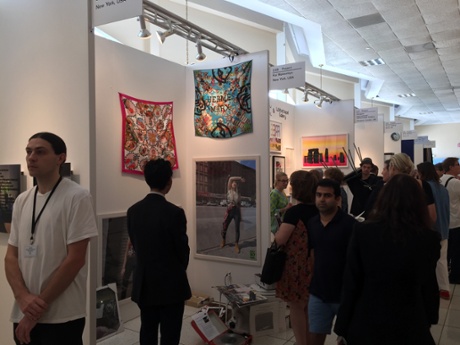
I’ll be posting highlights from the fair over the next hour or so. For the moment let’s say that the tone is serious, even if there seems to be a strong preference for safe, small-scale abstract painting that’s ideal for cash-and-carry transactions. There’s a lot I haven’t seen yet, though, so stand by.
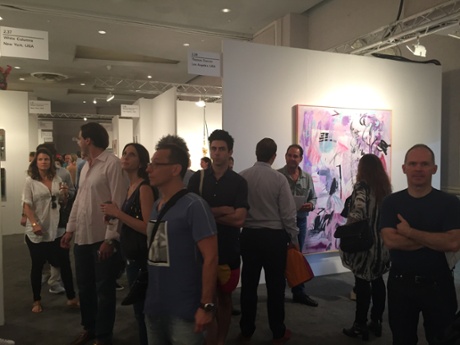
11.43am ET
As Jason has said, it was a very discomfiting experience going to glitzy artworld parties while New York, the city where we both live, erupted in protest at the grand jury’s decision not to prosecute police officer Daniel Pantaleo, who placed the unarmed black man Eric Garner in a chokehold, with fatal consequences.
This post on Hyperallergic, which juxtaposes a picture of the protests with art collectors having their brows soothed by Marina Abramnovic, eloquently expresses that feeling.
11.32am ET
Jason is en route to the NADA (New Art Dealers Alliance) art fair, the only one of Miami’s art fairs put on by a non-profitmaking organisation. I (Alex) am writing up my interview with Ryan Gander, taking a look at Andre 3000’s jumpsuits and supposedly concluding the day with dinner with Kim Kardashian (well, me and umpteen other people).
11.29am ET
Jason writes: meanwhile, Don and Mera Rubell, the Miami supercollectors, are currently celebrating their 50th anniversary with a cake-fueled early-morning gala.
We don’t wish the guillotine on anyone, but remember what happened to the last person who suggested eating cake…

